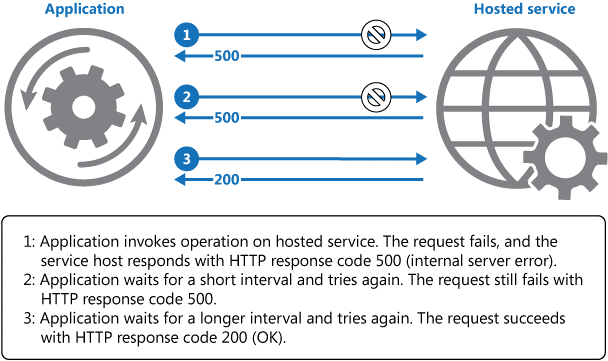An application that communicates with elements running in the cloud must be sensitive to the transient faults that can occur in this environment. Such faults include the momentary loss of network connectivity to components and services, the temporary unavailability of a service, or timeouts that arise when a service is busy.
These faults are typically self-correcting, and if the action that triggered a fault is repeated after a suitable delay it is likely to be successful. For example, a database service that is processing a large number of concurrent requests may implement a throttling strategy that temporarily rejects any further requests until its workload has eased. An application attempting to access the database may fail to connect, but if it tries again after a suitable delay it may succeed.
In the cloud, transient faults are not uncommon and an application should be designed to handle them elegantly and transparently, minimizing the effects that such faults might have on the business tasks that the application is performing.
If an application detects a failure when it attempts to send a request to a remote service, it can handle the failure by using the following strategies:
For the more common transient failures, the period between retries should be chosen so as to spread requests from multiple instances of the application as evenly as possible. This can reduce the chance of a busy service continuing to be overloaded. If many instances of an application are continually bombarding a service with retry requests, it may take the service longer to recover.
If the request still fails, the application can wait for a further period and make another attempt. If necessary, this process can be repeated with increasing delays between retry attempts until some maximum number of requests have been attempted and failed. The delay time can be increased incrementally, or a timing strategy such as exponential back-off can be used, depending on the nature of the failure and the likelihood that it will be corrected during this time.
Below illustrates this pattern. If the request is unsuccessful after a predefined number of attempts, the application should treat the fault as an exception and handle it accordingly.

Invoking an operation in a hosted service using the Retry pattern
The application should wrap all attempts to access a remote service in code that implements a retry policy matching one of the strategies listed above. Requests sent to different services can be subject to different policies, and some vendors provide libraries that encapsulate this approach. These libraries typically implement policies that are parameterized, and the application developer can specify values for items such as the number of retries and the time between retry attempts.
The code in an application that detects faults and retries failing operations should log the details of these failures. This information may be useful to operators. If a service is frequently reported as unavailable or busy, it is often because the service has exhausted its resources. You may be able to reduce the frequency with which these faults occur by scaling out the service.
For example, if a database service is continually overloaded, it may be beneficial to partition the database and spread the load across multiple servers.
Use this pattern:
This pattern might not be suitable: